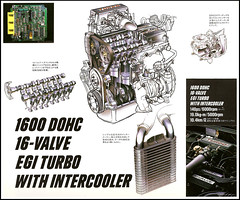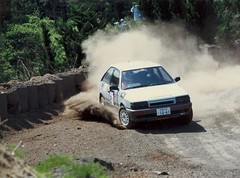Hands up if you, or someone you knew, ever owned a BFMR or BFMP Familia at some point. Now keep those hands up if you’ve ever blown a gearbox in one of ‘em before… just kidding.
it’s not hard to see how the humble Familia managed to garner a reputation over here as being the “Evo” of their day. when import laws were first relaxed in the early 1990s they were one of the most popular hi-po vehicles shipped to our shores directly out of Japan, purely due to their ubiquity and bang-for-buck value – at a time when most 2-litre turbo vehicles still remained the domain of rich middle-aged folks, the Familia with its smaller 1600cc B6T engine offered a sizeable chunk of the experience for comparatively little money. The fact that a locally-sold version (the Ford Laser) also shared the Familia’s mechanicals and drivetrain further added to its perpetuity.

1985 BFMR Mazda Familia GT-X
And as the decade wore on, the natural rate of devaluation brought them within easy reach of many an 18-year-old amping for their first taste of performance car nirvana.
The B6T’s specifications may seem like standard fare now: dual overhead cams, 4 valves per cylinder, multi-point fuel injection, turbo with intercooler. But when the engine was first released in 1985 it was hailed as a technological masterpiece amongst the Japanese motoring press – no doubt still coming off the buzz generated by Nissan’s FJ20ET two years prior (itself also a DOHC 4-valve turbo engine) – though most of the praise was directed at the new full-time 4WD drivetrain, designed from the ground up by Mazda to be complementary to the B6T from the outset. Okay, stop laughing! ![]()
Unlike the earlier E5T engine, with which it shared various technological features, the B6T (and indeed the entire B-series range of engines) was more of a clean-slate design, and as such was built to better withstand the rigours of forced induction. One of the biggest drawbacks of turbocharging the ‘old’ E5 was the inherent lack of cylinder head flow which throttled revability and top-end power considerably – the new DOHC head on the B6T did away with this problem entirely; peak net power of 140ps was obtained at a heady 6000rpm with a boost level of 7psi and factory redline of 7000rpm (which it reached with ease!) Curiously the torque figure had two peaks – first at 3000rpm, then again at 5000rpm, where it reached a max of 19.0kg-m. The turbocharger was a RHB5 unit supplied by IHI (watercooled for maximum longevity), and the intercooler a Nippon Denso core which was front-mounted for full chilling effect.
It may be interesting to note that the B6T’s naturally aspirated brother the B6D shared many of the same internals including the crank, conrods, cylinder head and much of the valvetrain.

While Subaru is credited as being one of the first Japanese manufacturers to feature 4WD in their passenger vehicles, Mazda's implementation in the Familia was the first to offer full-time operation, in a transverse layout.
from the outset it became clear why Mazda had so thoughtfully developed the full-time 4WD drivetrain, as the base FWD “GT” version – whilst a nimble, competent handler – only tipped the scales at 970kg and had a reputation for hearty torquesteer and traction problems off the line. The four-paw ‘box and associated guff added an extra 90kg to the mix but brought vastly improved tractability and unmistakeable go-kart handling, so much that it went on to form the basis of Mazda’s Group N and Group A rallying platform during the mid-to-late 1980s (taking over most duties from the SA22C RX-7).
It was the exposure in the world rally scene which led Mazda to deem the B6T one of three turbocharged engines important enough at the time to market at a global level (the others being the 13BT rotary from the FC3S RX-7 and F2T from the MX-6/Probe), and was introduced to the European, North American and Oceanic markets in the 1987 323 “GT” and “GT-X” models (plus the Ford Capri XR2 and Laser TX3 for the latter) with varying power and torque figures due to emissions laws.
No other Japanese manufacturer was able to match the combined performance and handling levels offered by the B6T powered Familia 4WD until 1987, when Mitsubishi released their 4G61T and corresponding “VCT” full-time 4WD system. This new platform powered the C73A Mirage/Lancer – predecessor to the Galant VR-4 and Lancer Evo models, two vehicles which introduced yet another level of performance to the masses whilst simultaneously retaining the semblance of affordability which had made the Familia such a worthwhile package.
suddenly, the pain of all those broken gearboxes seems worth it after all.
|
technical specs
Mazda B6T (Japanese spec) Bore x stroke (mm): 78.0 x 83.6 |




Hello,
Ugh, I liked! So clear and positively.
Thank you
Pett
nice and brief comment…i’ll rise my hand…bfmr owner..
If youre looking to import a car from Japan I recently used Algys Autos Ltd. I did a lot of research first and looked around. These guys have garages in jApan and the UK, I read their testimonials and even contacted a few past customers. All was good. I took the ‘leap of faith and went for it.They will source any model of a Japanese or European car you wish from any age and specification via their Japan garages. Prices are keen and quality is excellent. All models seem to be in their reach. The import process concudes when the car is registered and ready for collection from the Bristol garage. They have full dealer facilities and can also arrange for full UK registration. Visit the site where there are loads of photos and vehicle specifications etc. My mate did one from them a while ago I’ve learnt since…and he had his delievered by them to his home. Gotta be good!
These are awesome cars to work on and drive. As New Zealand Car Performance Mag once pointed out in an article, if you owned one of these in the 90′s you were GOD!
i owned an 87 ford laser fwd for my first car now 2 and a half years later i have an 89 mazda wagon with another b6t in it, ar.60 turbo but i wana buy some parts for it.. its sad that no one has off the shelf upgrades for them any more
Wonderful cars but those machines have one weak point. AWD transmission..
I still own my 1985 mazda bfmr and have neva had to replace the gear box still gos mint as i love the power off the we beast. A good way to keep your bfmr gear box in good nick is dont launch them they dont like it that how my old 1990 gtx gear box blew to pieces lol.